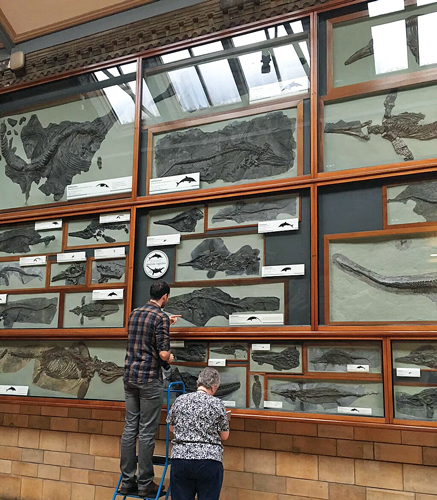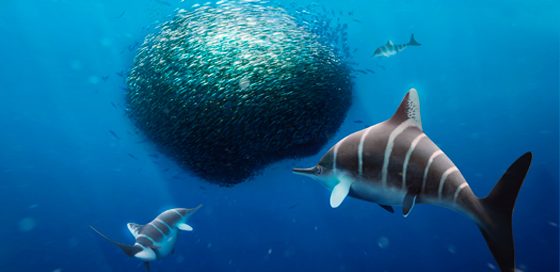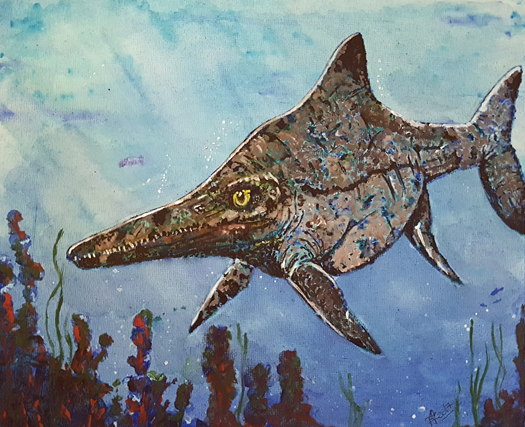Unravelling a Fishy Tale
Reassessment of Ichthyosaur Material Solves Century Old Mystery
Ichthyosaurs were a very successful group of marine reptiles. They originated during the Triassic and thrived in the seas of the Mesozoic and had a global distribution, but towards the end of the Cretaceous, these dolphin-shaped animals, that seemed so perfectly adapted to their environment, became extinct.
They were the first, large extinct reptiles brought to the attention of the scientific world. It is difficult to avoid mention of the ichthyosaurs when looking at information that outlines the history of palaeontology, however, despite first having been described nearly 200 years ago, (1821), there is still a lot we don’t know about these iconic “fish lizards”.
The Iconic Ichthyosaurus
Picture credit: Robert Richardson
The Long History of Ichthyosaur Research
It is the long history of scientific study and research into the ichthyosaurs that has proved to be a bit of a headache for today’s palaeontologists. Dean Lomax, a palaeontologist and Honorary Scientist at The University of Manchester, working with Professor Judy Massare of Brockport College, New York, have studied thousands of ichthyosaur specimens and have delved through hundreds of years of records to solve an ancient mystery, a mystery that dates back to the early 1820s, when the English geologist William Conybeare, described the first species of Ichthyosaurus.
Many ichthyosaur fossils were found in England during the early 19th century, but it was not until 1821 that the first ichthyosaur species was described called Ichthyosaurus communis. This species has become one of the most well-known and iconic of all the British fossil reptiles, after all, an ichthyosaurus even featured on a set of specially commissioned Royal Mail stamps to celebrate 150 years of British palaeontology!
To read article about the Royal Mail commemorative stamps: Royal Mail Issues New Prehistoric Animal Stamps.
In 1822, three other species of Ichthyosaurus were described, based on differences in the shape and structure of their teeth. Two of the species were later re-identified as other types of Ichthyosaur, whereas one of these species, called Ichthyosaurus intermedius, was still considered closely related to I. communis.
Ichthyosaur Research
In the years that followed, many eminent scientists, including Sir Richard Owen (the man who coined the word dinosaur), studied “fish lizard” fossils collected from Dorset, Somerset, Yorkshire and other locations in England. Their studies and observations of Ichthyosaurus communis and I. intermedius resulted in confusion with the species, with many skeletons identified on unreliable grounds.
Commenting on this palaeontological puzzle, Dean Lomax stated:
“The early accounts of ichthyosaurs were based on very scrappy, often isolated, remains. This resulted in a very poor understanding of the differences between species and thus how to identify them. To complicate matters further, the original specimen of Ichthyosaurus communis is lost and was never illustrated. Similarly, the original specimen of I. intermedius is also lost, but an illustration does exist. This has caused a big headache for palaeontologists trying to understand the differences between the species.”
Hunting for Clues to Help Solve a “Fish Lizard” Mystery

Dean Lomax and Judy Massare examining Ichthyosaur specimens in the marine reptile gallery at the Natural History Museum (London).
Picture credit: Dean Lomax
To visit the website of Dr Dean Lomax: British Palaeontologist Dr Dean Lomax.
Attempts to Tidy Up a Taxon
In the mid-1970s, palaeontologist, Dr Chris McGowan was the first to suggest that Ichthyosaurus communis and I. intermedius may represent the same species. He could not find reliable evidence to separate the two species. Subsequent studies argued for and against the separation of the species.
In this new research, Dean and Judy have reviewed all of the research for and against the separation of the two species. This is the most extensive scientific study ever published comparing the two Jurassic-aged marine reptiles. The pair of scientists have confirmed that the species are the same and that features of Ichthyosaurus intermedius can be found in other ichthyosaur species, including I. communis.
It seems that the fossil material ascribed to the species Ichthyosaurus intermedius lack any autapomorphies – distinctive features or derived characteristics and traits that are unique to that taxon.
Thanks to the efforts of these two researchers, a fishy tale that is over a hundred years may have been resolved.
For models and replicas of ichthyosaurs and other marine reptiles: CollectA Prehistoric Life Figures.
In recent years, the duo have described three new species and have provided a reassessment of historical species. Their work has provided a far superior understanding of the species than has ever been produced.
The scientific paper: “A taxonomic reassessment of Ichthyosaurus communis and I. intermedius and a revised diagnosis for the genus” by Judy A. Massare and Dean R. Lomax published in the Journal of Systematic Palaeontology.
Visit Everything Dinosaur’s award-winning website: Everything Dinosaur.



